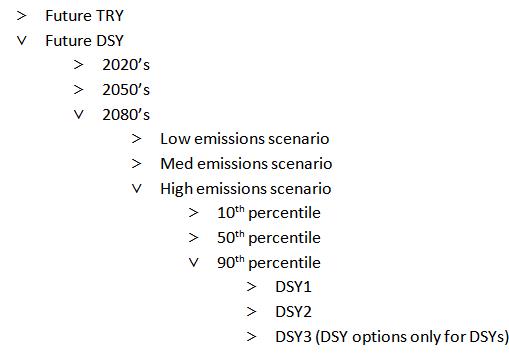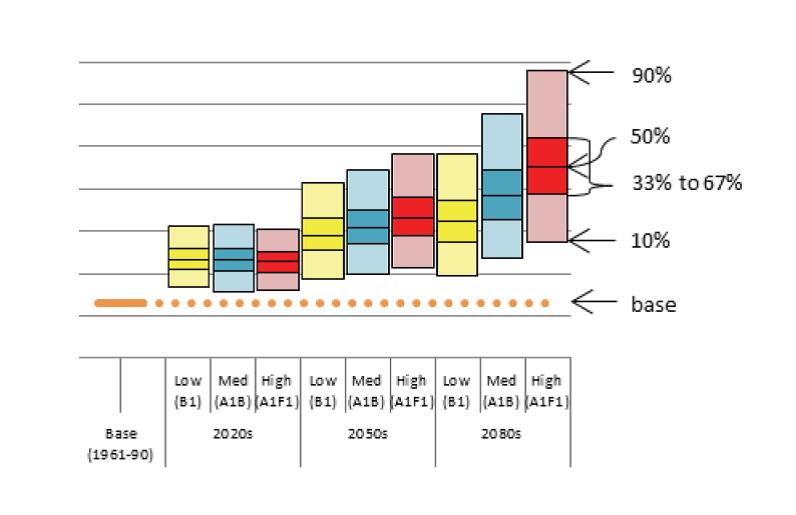What’s with the weather?
 We have been taking a look at the new weather files that CIBSE have put out to replace the TRY and DSY datasets produced in 2005.
We have been taking a look at the new weather files that CIBSE have put out to replace the TRY and DSY datasets produced in 2005.
The same 14 locations have been used, but the files have been through a rigorous process to select the data using an updated baseline of weather years (1984 to 2013). This has ironed out some of the anomalies known to exist within the old DSY files.
The published dataset is HUGE. For each of 14 locations there are:
- Current TRY
- Current DSY1 – featuring moderately warm summer
- Current DSY2 – featuring short intense warm spell
- Current DSY3 – featuring long, less intense warm spell
Note: three new DSYs to replace the one old one for each location.
The future weather files have been morphed based on the UKCIP09 projections and include the following options for each location:
This structure for the future files allows the Probabilistic climate profiles (ProClip) charts to be used for selecting which future file is appropriate for each project. An example is shown below. These charts are available in this doc from CIBSE which includes charts for all the 14 locations.
They show how all the future files compare for each of 4 key variables:
- Seasonal mean air temperature (Winter, Spring, Summer Autumn)
- Daily minimum temperatures for winter
- Daily peak temperatures for summer
- Seasonal daily precipitation (Winter, Spring, Summer Autumn)
This gives the user some context to choose which files to use (rather than just selecting the 2050 Med emissions 50% file by default!).
The set also includes the TM49 data made available for London last year with three different London locations:
- London Gatwick (rural) – LGW
- London Heathrow (sub-urban) – LHR
- London Weather station (inner urban) – LWC
Including these three sites allows for different degrees of urban heat island (UHI) effect to be included within the data. This effect is known to increase night-time temperatures significantly in built up areas. The advice is to use the data most appropriate to your site location.
Whilst we are pleased to see this new wealth of data made available, we are also wary that running models against multiple weather files could be an onerous task and multiple sets of results could muddy the advice we give clients.
A current example (and one we are prone to keep on about) is that of domestic overheating risk assessment. The GLA (Greater London Assembly) have picked up on the change from recommending a test based on hours above a certain threshold (26°C in bedrooms and 28°C in living rooms) recommended in the CIBSE A guide 2006, to the TM52 adaptive thermal comfort approach advocated in the latest CIBSE A Guide 2015. They also now require assessment against the three DSY weather years and potentially future weather files.
There are several unintended problems with this:
- TM52 was not written with domestic occupancy in mind and does not include guidance on the hours of occupancy to assume. This makes a massive difference to the results as excluding all daytime hours (assuming people are out during the day) makes it much easier to pass. We firmly believe TM52 needs some refinement and more guidance if it is to be effective in the domestic arena.
- Running models against multiple weather files at the pre-planning stage is time consuming and raises questions about where the pass/fail threshold sits – do designs need to pass the criteria for all 3 current weather files – including the extremely hot summer of 1976?
- Running tests that include 24/7 occupancy (worst case) on the highest (overheating) risk units should be the most robust way to confirm that all units in a development comply. However, we have found that running the analysis in this way makes it impossible for all units to pass and also meet the energy efficiency targets (e.g. FEES – Fabric Energy Efficiency Standard) and daylight requirements, particularly in the case of a lightweight construction.
- Design teams wanting to do the ‘right thing’ re reducing overheating risk are being asked to do a lot more legwork and are still left in an ambiguous position re how much mitigation is sufficient.
Inkling are currently working with Arup and CIBSE to put forward a domestic overheating risk assessment methodology which gives specific guidance on how to use TM52 for this purpose. We hope to publish later this year. Watch this space!
 Posted by Susie Diamond
Posted by Susie Diamond- Posted in CIBSE, Research
 May, 25, 2016
May, 25, 2016 Comments Off on What’s with the weather?
Comments Off on What’s with the weather?

 Susie: 07972 263 676
Susie: 07972 263 676



 Join Us On In.com
Join Us On In.com

